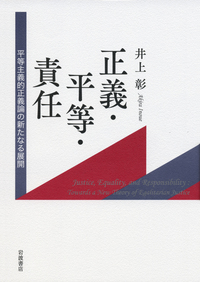
Title
Jinko mondai no seigiron (Theories of Population Justice)
Size
264 pages, A5 format
Language
Japanese
Released
January 30, 2019
ISBN
9784790717256
Published by
Sekaishisosha
Book Info
See Book Availability at Library
Japanese Page
The study of issues in population is a classical topic. Since Thomas Malthus published An Essay on the Principle of Population in 1798, there have been discussions about the necessity of population control. This topic has once again garnered attention. Since the late 20th century, environmental, immigration, and refugee issues triggered by population changes and migration on a global scale have become matters in need of urgent resolution.
Our book, Jinko mondai no seigiron (Theories of Population Justice), an anthology in normative theory, aims to respond to such population issues. Derek Parfit’s Reasons and Persons (1984) marked the beginning of this response. Parfit argued that, in evaluating states of affairs involving population groups of heterogeneous members and varying sizes, existing normative theories, such as utilitarianism and contractualism, cannot make appropriate evaluations. He argued that the very search for Theory X was a fundamental issue in normative theory.
Two essays in Part I explore this theme. In Chapter 1, Makoto Suzuki proposes a kind of utilitarianism that can be transformed into either a positive or negative philosophy based on the zero well-being level. In Chapter 2, Akira Inoue argues that sufficientarianism (a theory of distributive justice that has been influential in recent years) cannot meet the requirements for Theory X. When reading those essays, along with the two essays in Part V (those of Makoto Usami in Chapter 9 and Susumu Morimura in Chapter 10), which explore theories of justice for future generations, one becomes acquainted with cutting-edge discussions on the theories of population justice.
Of course, this book collects two essays that echo the debates on the long-standing issues of optimal population size and population control. In Chapter 3, Kohei Kamaga articulates a utilitarian evaluation method that presents an optimal population size. In Chapter 4, Masakazu Matsumoto attempts to find a theory that can manage the basic human rights issues that population control policies encounter. Both authors aim to build their own normative theories that can be applied in practice. The issues of optimal population size and population control are also linked to matters of reproductive justice, such as the right to have children. In Chapter 5, Akiko Nozaki examines the complex public and private aspects of having children by considering the reproduction policies in Japan. In Chapter 6, Naomi Tsuruta points out that if we focus on the significance of pain emphasized by the anti-natalism of recent years, individuals’ experience of pain and suffering may lead them to have richer lives. Both chapters powerfully explain that reproductive questions have a bearing on basic philosophical problems.
Part IV is one of the key sections of this book. In the face of immigration and refugee challenges rooted in global population movements, this section is topical and a must-read. Masato Fukuhara’s essay in Chapter 7 on the tension between freedom of movement and national sovereignty, and Taichi Kishimi’s work in Chapter 8 on the practical issue of foreign domestic workers in developed countries examine the key points of the topic. Both essays provide a basic consideration of the immigration and refugee problems that Japan has been facing.
All of the chapters provide powerful arguments and persuasive views. It is my hope that many people will read this book and use it to sincerely examine, from a normative perspective, population issues that are both longstanding and new.
(Written by INOUE Akira, Associate Professor, Graduate School of Arts and Sciences / 2019)



 Find a book
Find a book





